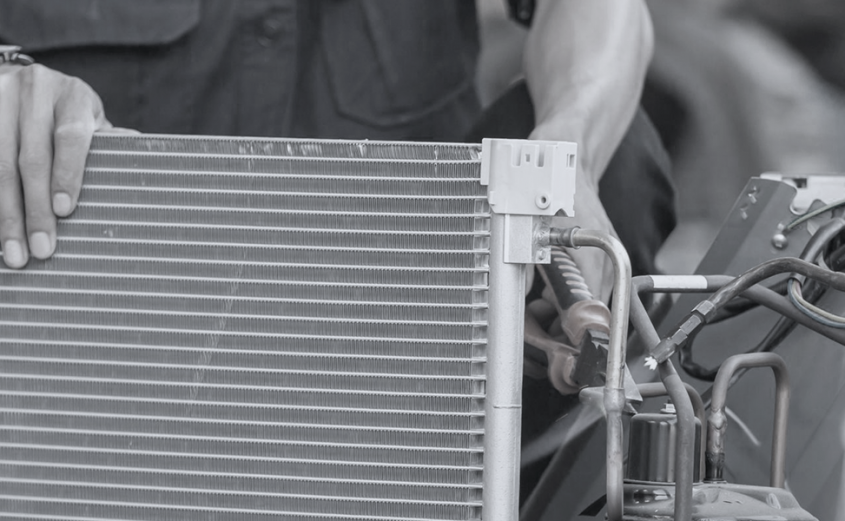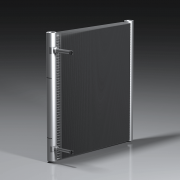Microchannel coil: fix or replace
by Lance Robinson
I vote for fix. Anytime you can fix a condenser as opposed to replacing it, is a good day for all in the repair business. Less time = more money. Customers are happier and all around better vibe. Replacement of perfectly good coil makes no sense. Instead make the fix in less than 5 minutes with a propane torch and a few simple instruments all HVAC techs have on hand.
Microchannel condenser coils are all aluminum coils with multiple flat tubes containing small flat channels through which refrigerant flows. Heat transfer is maximized by the insertion of angled and louvered fins in-between the flat tubes. These channels are not only fixed with ease but the header manifold and copper tubing as well.
Ease Of Service And Repair
Microchannel coils are easily cleaned and can be field repaired using a simple alloy based solder. These microchannel coils are less than two inch thick allowing for easy removal of any debris that may be caught within the coil. This is not so with fin/tube coils, which are often much thicker with staggered tube patterns using corrugated fins which make debris removal difficult, if not impossible, in some circumstances. The durability of microchannel coils also allows for pressure washing (using a broad spray pattern), which is not recommended with fin/tube coils. Coil leaks, while unlikely, can also be easily repaired in the field using a simple process. Multi metal solder, a cleaning solution, a vacuum pump, a few simple tools, and a little bit of practice is all that is required.
Microchannel coils are constructed to reduce size, use less refrigerant, be more durable, transfer heat better and eliminate formicary corrosion. So, when you’re brazing, you want to braze with low temp and a propane torch or map gas, constantly moving the flame so as to not make the problem worse by melting the channel. Use multi metal solder to make the repair. The solder and flux is designed specifically to bond directly to the metal thus keeping B-B’s or slag from forming in your repair. This also will prevent the black oxidation flakes from forming inside the lineset itself as you’re brazing. Thus, when you release the charge and the refrigerant is moving through the system, you have a smooth steady flow in the microchannel coils. Braze as you normally would with a standard fin/tube coil. You’d do the same thing here on the microchannel coil.
Fin/Tube vs. Microchannel
With the introduction of microchannel coils, some service practices have changed from traditional copper tube and aluminium fin coils. It is important to understand that microchannel coils hold a relatively small volume of refrigerant. First thing to remember is because of this, you cannot pump down microchannel coils when you need to service other parts of the system like you have done in the past with tube and fin coils.
Secondly, gauge sets should be connected only when necessary for service. Again, since the systems only hold a small volume of refrigerant, every time you put your gauges on the system and fill your hoses with part of the system charge, you could be affecting the performance of the system.
A slight (ounce to a few ounces) under-charge can impact the unit’s performance. Use your gauges sparingly. When you do have to attach a gauge set, if you have bled off the “charge” in your hoses for transport, re-charge the hoses and purge them before attaching them to the unit and make sure your low loss fittings are working.
By charging your hoses, you are keeping both non-condensables out of the system and assuring you are not affecting the unit charge. Keep in mind that the gauge set hoses should be considered when charging a unit. Also, make sure you turn off or close the low loss fittings on your gauges before removing them from the system to avoid loss of refrigerant from the system.
If you find that you do have to adjust a unit charge, a complete recharge by weight to the nameplate value is the best method for “charge adjustment”. A slight over-charge, or any non-condensables can cause high pressure trips, especially at times of compressor starts in higher ambient.
I need to emphasize the point that because the condenser holding volume is so small, these units can be unforgiving when the refrigerant charge is not precise. So the refrigerant charge on microchannel units is critical.
You must use a digital scale to weigh in, or out, the refrigerant when you are adjusting the charge. Add or remove only small amount of refrigerant per adjustment and wait at least 15 minutes per adjustment. This allows the refrigerant in the system to circulate and equalize itself in the system.
It is a slow process but it will prevent recalls for over charge pressure switches tripping, or under charged and a “not enough cooling” calls. It all goes back to do it right the first time.
Of course, good brazing practices with a nitrogen trace running through the system and evacuation to 500 microns with a micron gauge is also critical to a properly performing system. Since moisture is a non-condensable, and since the charge is critical, even a little bit of moisture left in a system can cause nuisance head pressure trips. Nitrogen actually displaces the oxygen inside the line, which prevents oxidation, you can see this oxidation on the outside of the line when you are brazing. That’s what will happen to the inside without nitro.
Lance Robinson is Executive Director of D23 Systems in Las Vegas, NV. With over 20 years of experience in the HVAC industry, Lance has served as a valued adviser, educator, and partner to the Las Vegas construction industry and it’s building owners. His extensive training in HVAC products and systems has earned him a reputation for being able to develop efficient, effective, and innovative building systems, providing more than simple product selections.
Kaltra is a world-known provider of cooling technologies and advanced cooling products for mission-critical applications, such as data centers, clean rooms, contaminant-free areas, processing plants, and other facilities where reliability and energy efficiency are key factors. Kaltra’s cooling equipment range includes precision cooling systems, air-cooled and water-cooled chillers, evaporative cooling solutions, dry coolers, and condensers.
Kaltra offers microchannel heat exchangers for the condenser, evaporator, fluid-to-air applications, and in-stock replacement coils distinguished from original OEM coils by higher performance, and considerably longer service life reinforced through the use of advanced aluminum alloys and protective coatings.
For more information on Kaltra and its products call +49 911 715-32021 or visit www.kaltra.de








